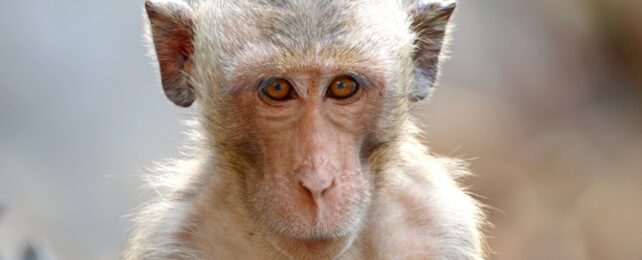Scientists have grown embryo-like models using monkey stem cells for the first time, which when implanted in surrogate monkey 'mothers' appear to progress through the earliest stages of gestation.
Human versions of these models have already been created from stem cells, but until recently a 14-day limit applied to scientists growing them for research. What's more, transplanting them into a human surrogate is presently way out of the question, making it difficult to use the models to study embryonic development under real-world conditions.
In search of an alternative approach, team of Chinese researchers have turned to the most closely-related species they can: the crab-eating macaque (Macaca fascicularis).
The scientists exposed macaque embryonic stem cells in a cell culture to a careful selection of growth factors. The cells proceeded to form embryo-like structures known as blastoids (a term which distinguishes these stem-cell derived structures from naturally-occuring blastocysts).
A quarter of the experiment's stem cells progressed into a blastoid form, a success rate on par with previous experiments using human embryonic stem cells. These were then cultured in a lab until they began to form three distinct layers in a process known as gastrulation, a key moment in embryonic development that sets up a basic body plan. Several of these blastoids progressed to form a yolk sac and amnion (the fluid-filled membrane that covers a developing embryo).
Under the microscope, the scientists noticed the blastoids had similar features to stage 7 embryos (in humans, this stage occurs at around 18 to 21 days after fertilization).
This monkey embryo model tended to collapse at around 18 days growing outside of a body, though in future experiments the researchers plan to explore other systems that have been successful in culturing mice blastoids.
Creating the monkey blastoids was only half of the experiment: some were also transplanted into the wombs of eight female monkeys.
The scientists selected blastoids that had been cultured for seven days, which had an inner and outer cell mass and a visible cavity, since these are key features of natural embryos. Each surrogate monkey was 'impregnated' with 8 to 10 blastoids and monitored using ultrasounds and hormone testing over the next 20 days.
The embryo-like structures successfully implanted in three of the surrogate mothers, forming early gestation sacs (the fluid-filled membrane that encloses the embryo and amniotic fluid) that lasted a week or more after transplantation. Surrogate mothers also had increased levels of progesterone and chorionic gonadotropin, hormones associated with pregnancy.
All of the embryonic structures had disappeared entirely after about a week, but the fact that they implanted and triggered the release of these hormones suggests that for a brief moment the monkeys were in fact pregnant.
Conducting similar experiments using human cells and surrogates might tell us a lot about our own biology and its potential to result in disease and disorder, but at an ethical cost few would be comfortable paying. The use of macaques comes with its own controversy: primate experiments like this are banned in many places across the world.
A co-author on this paper, neuroscientist Qiang Sun, is director of the non-human primate facility at the Chinese Academy of Science (CAS), where this experiment was conducted.
In his career he has created a pair of cloned macaques, Zhong Zhong and Hua Hua, and discovered a short-cut to sexual maturity by grafting the testicular tissue of young macaques onto mice.
Sun believes generating a large amount of gene-modified monkey models quickly and efficiently will "promote the development of animal models relevant to human disorders and deepen our mechanistic understanding in life science".
Others say such experiments cannot be justified, when animal studies don't reliably predict human outcomes, and are so rarely translated into real-world human treatments.
Co-author Zhen Liu, a reproductive scientist, said the experiment will help understandings of human embryogenesis, because monkeys are so closely related to humans.
"We hope the study of these models will deepen our understanding of human embryonic development, including shedding light on some of the causes of early miscarriages," Liu said.
This paper was published in Cell Stem Cell.
